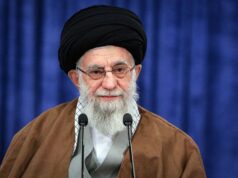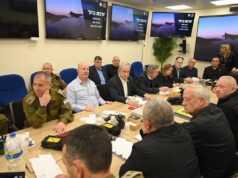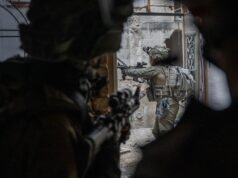Israel
Since the start of Operation Protective Edge, the IDF has deployed an additional three Iron Dome anti-missile systems, giving Israel ten active batteries, to combat the firing of over 1,840 rockets. The system has reportedly achieved a 90 percent success rate. Last week, Prime Minister Benjamin Netanyahu fired Deputy Defense Minister Danny Danon following his strident criticism of the initial cabinet decision to postpone a Gaza ground invasion.
The IDF received its first Alenia Aermacchi M-346 “Lavi” at Hatzerim airbase on July 9th. The jet, replacing the aging TA-4 fighter, will contain new Israeli customized avionics that will make the fighter more “responsive” to the air force’s operational needs.

A version of the M-346. (Photo: Airforce-Technology.com) |
In order to fulfill its goal of becoming a global cyber power, the Israeli Cabinet approved tax incentives to create 3,000 cyber-related jobs in the Negev over the next 10 years.
An Elbit Systems subsidiary secured approval to manufacture 16 unique components of the F-35 Joint Strike Fighter. In a 10-15 year, $2.5 billion contract, Israel Aerospace Industries (IAI) will also make 811 pairs of wings for the advanced stealth fighter. The first article F-35 wing assembly will begin in September 2014 with the first delivery expected in mid-2015.
Iraq
A U.S. official told Military Times that the planned delivery of F-16 fighter jets to Iraq will be postponed until the security situation improves. In Tucson, Arizona, the USAF is currently training 12 Iraqi pilots to fly the aircraft. Meanwhile, the Pentagon awarded General Dynamics Land Systems a $65 million contract to support and train the Iraqi Army on the M1A1 tank.
Jordan
Jordan will arm six turboprop IOMAX Border Patrol Aircraft, donated by the UAE, with six GBU-58 250lb precision-guided bombs and/or six AGM-114 Hellfire missiles. Jordan renewed an army recruitment drive due to a “general shortage” of troops. Amman has been seeking to shore up defenses after the recent advances of radical jihadists across the Levant.
Tech
IAI introduced a new helicopter safety system that generates an image to warn pilots of uneven terrain and power lines during flight, easing landing conditions. Elbit systems also displayed a new Helicopter Skylens wearable head-up display for commercial pilots. The gadget is worn like ski goggles and displays a high-resolution of symbols and videos on its visor.
IAI’s Barak 8, a new surface-to-air missile system, received the technological innovation award in the air defense sector. The system provides defense capabilities against aircraft, helicopters, and missiles.
IAI also revealed its BirdEye 650D mini UAV. The new edition increases the air vehicle’s battery life to 24 hours. Jerusalem also uses UAVs to help safeguard the city’s light rail system, which was recently vandalized during the Arab riots.
Turkey
The Turkish military released a statement on July 7th detailing the first flight of Atlas, a giant A400M acquired from Airbus in May. Atlas provides Ankara with its first strategic airlift capability.
Turkish Aerospace Industries (TAI) expects to sign its first export deal for the Anka unmanned air vehicle by the end of the year. Turkey itself expects to receive the first delivery of the Anka, which is similar in size to the Heron and Predator, in 2016.

The Turkish A400M in London. (Photo: Hurriyet Daily News) |
Eight U.S. sailors from the USS Mesa Verde visited two Turkish Navy frigates while Turkish Navy officers toured the Mesa Verde near the Gulf of Aden. The deployment marks the first time since 1866 that Turkey has circumnavigated Africa.
Gulf
Having already spent $5.4 billion, the United Arab Emirates plans to establish the first Gulf Arab space agency and intends to conduct a fully indigenous mission to Mars by 2021.
In the largest American sale of weapons this year, Qatar will buy 10 Patriot anti-missile batteries, 24 Apache helicopters, and 500 Javelin anti-tank missiles in an $11 billion deal. Qatar would become the 13th user of the Patriot system. In its first sale under new arms export guidelines, Japan approved the export to Qatar of a Mitsubishi-built sensor to be used in the PAC-2 air-defense system.
In early July, the first of three Kuwait Air Force KC-130Js landed at Marine Corps Air Station Cherry Point, N.C. Four Kuwaiti pilots have been there since February to conduct flight training. Two additional Super Hercules are scheduled to arrive at Cherry Point in the upcoming weeks.
Oman is purchasing two new 72-meter High Speed Support Vessels (HSSVs) from Australia’s Austal for $124.9 million. Construction is scheduled to begin this year.
Egypt
French shipbuilder DCNS has sold four Gowind warships, with an option to buy two more, to Egypt. Rumored to be worth $1.4 billion, the first 2,500-ton corvette will be built in France and the remaining three in Alexandria. Egypt has also ordered eight more Airbus C295 transports to be delivered next year. The deal makes Egypt the tactical airlifter’s largest customer, which is used for daily military transport missions.
Sales
Rafael is in discussions with the UK Ministry of Defence regarding the potential integration of the former’s TopLite Multi-High Definition electro-optical payload onto Royal Air Force aircraft. The pod incorporates a variety of sensor types and a similar Litening airborne targeting pod is used on the service’s Eurofighter Typhoon and Panavia Tornado GR4 jets.
The Philippines is fast tracking the acquisition of air defense surveillance radars from Israel’s Elta Systems in a $63 million deal. While the first radar is expected to be installed in less than two years, Elbit has offered to provide one “freebie” radar by early next year.





